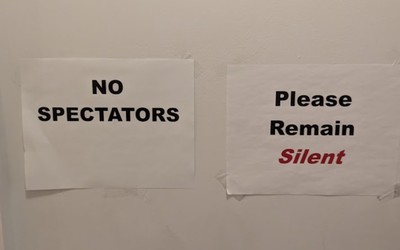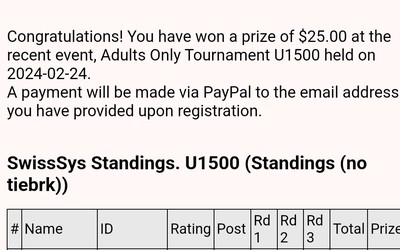
Danny Rohde, uschess.org
IA Harding Memorial 2023 Recap
Some games to forget, but lessons to remember.Introduction
On Friday, I played in the Harding Memorial, a 6-round G25d5 Swiss tournament at Marshall Chess Club. The tournament was originally named the "Day After Thanksgiving Open," but was renamed out of respect for the untimely passing of IA Andre Harding.
https://new.uschess.org/news/ia-andre-harding-1983-2023
I didn't know him, but it's clear he had a tremendous impact on those whose lives he touched.
Tournament crosstable:
https://www.uschess.org/msa/XtblMain.php?202311243922-30684520
Micro-goal Review
I entered this tournament with few expectations, knowing that it would be very strong. I was looking only to execute the micro-goals I blogged about recently. Unfortunately, in several of the games I blundered in a manner that I wouldn't even in a 3+2 blitz here on Lichess - the lesson primarily being that I need to redouble my focus on "tactics before strategy" (and definitely "everything else before opening preparation") - when playing OTB games.
Embarrassing 100 ELO blunders aside, here's a preliminary review of my current micro-goals:
1) Play mainlines and principled moves in the opening.
I think I did this, but perhaps "too much" as I lost sight of the tactics on the board and blundered. But at least I didn't play quirky responses and was *trying* to play mainlines.
2) Don't recapture any piece without taking at least one minute to calculate
I did do this, which probably is why I was in time trouble in these G25d5 games.
3) Recognize key moments in the game.
I noted these moments in my notation, and for the most part I think I was correct (may need deeper analysis). That is to say, the game was even and changed one way or the other after the move.
4) Do the work of calculating potential tactics and checkmates.
In games where I had a winning a position, I was careful to check and double-check before making the winning move, rather than rushing to make the move impulsively.
5) Immediately deal with batteries.
Did not occur in any of my games.
6) If needed, win with a single pawn.
I did not have a game where I won with a single pawn advantage, however I did have a game where pushing and queening my remaining pawn was key to converting a win... where I had only 3 seconds left on the clock (with 5 second delay)!
One additional goal I had set for myself in the tournament was: "look at my opponent's pieces first and find their best move before making your own." I fell very short of this objective, resulting in several absolutely embarrassing, uncharacteristic blunders - as we shall see.
Game Recaps
For games that I lost, I also found a model game where a GM executed a win from a similar opening line.
Game 1 - Baranawal vs Zucker
In this game, I learned that in the French Advance Variation 5. ... Bd7 is preferred to Ne7 (which I usually play for some reason? No more...)
I blundered a pawn early but actually had a somewhat equal game due inaccurate play by my opponent...until I liquidated to a losing endgame...!?
A similar game where black plays 5. ... Bd7 as recommended:
Openings matter. "Knights before Bishops" is what they tell you, but in this line that's the wrong move.
Game 2 - Zucker vs. Malhotra
This one is a throw-away loss. I played an embarrassing blunder because I was playing an opening line "from memory" (but with wrong move order...classic) and lost the game. Taking a page from the book of scholastic players, I didn't resign until checkmate was inevitable and I had < 2 minutes left.
Nakamura - Onischuk (2016) the Streamer correctly plays the top move, 8. Be3
Game 3 - Winn vs. Zucker
I face the Ruy Lopez again as black, but don't find the right moves. I still have trouble understanding black's plans in this opening. For example, I thought 6. ... b5 was the obvious move, but the top move is g6?? I need to analyze this more and perhaps have a better player explain.
If you don't memorize lines and learn theory, how do you figure out "over the board" that moves like g6 are the best move?
I lost on a blunder, but what set up that blunder?
- I played 9. ... Bg4?! - "pinning" white's f6 knight - only to have it chased away allowing white to start a kingside pawn storm and cramping my position. Lesson: only play this when white has castled kingside and moving the pawn cover potentially weakens his position (or don't play it at all, and instead play Bb7.
- I suspect I needed to open the center once white started pushing kingside pawns.
Side note: my opponent's provisional rating was earned almost 20 years ago at the Scholastic K-6 U900 US Championship(!). After my game he beat a pair of 1300-rated, so I suspect that provisional rating is indeed a bit inaccurate :)
In this model game, Krejci plays 12. ... g6 and fianchettos both bishops.
Game 4 - Zucker vs. Brink
Having lost my first 3 games, I now found myself in the "boiler room" - the last board all the way at the back of the Club, playing a similarly winless scholastic player. I played the Evans Gambit again and this time got some semblance of move order correctly - but more importantly calculating instead of blitzing out wrong moves.
My opponent played an odd-looking move that actually is the third-most popular continuation of the Evans Gambit for black accepted.
Game 5 - Chang vs. Zucker
After finally winning one game, I was served up another scholastic player...such is your fate when you drop 3 straight in a tournament like this. In any case, my young opponent didn't know how to play the French at all, and quickly was in a losing position. I had to calculate early however, given white's moves were completely off-book and tactical.
Here is a game played by Daniil Dubov where he indeed played the Two Knights variation of the French (and lost):
Game 6 - Raitzin vs. Zucker
Before this game, I overheard my young opponent commenting that "nobody has played e5 against me today!" I suppose I could have used this bit of "intelligence" to disappoint him with another French Defense (my current alternative to 1. ... e5 - I don't yet play the Sicilian). However, I resolved to play into his opening and see what happens.
To my surprise, he played for a Fried-Liver against my Two Knights Defense. Now, I have lines against this somewhat prepared... Unfortunately, I touched my f7 pawn and only realized immediately upon touching it that moving it was a blunder because of Qh5+ (again!). I didn't want to cheat or be lame and take a time penalty, so I moved the piece anyway - this lost me the game for sure.
(I'm playing these games to learn lessons, not to "win," so I would rather ingrain this lesson into my brain than violate touch-move and not be able to sleep that night).
In any case, aside from learning why players often "hover" their fingers over a piece before moving it (something I didn't understand and found somewhat annoying - but which I'll now do as well) - I learned why the critical move in this line of the Two Knights is 8. ... Nd5! This attacks white's g5 Knight, forcing a response.
For my model game, I found a match between So and Carlsen, where the later played the correct move and proceeded to execute an immediate, fearless kingside attack.
Recap of the Recap: Lessons Learned
- Look at your opponents pieces first, before your own, when you evaluate the position and pick your candidate moves. I did not do this consistently - the main reason I blundered repeatedly.
- After move...3 stop thinking about opening preparation and look at tactics first. Especially opponent's tactics. Use opening lines as a guide for suggested moves, but evaluate them in the context of the position (even if you think you're playing a prepared line!)
- Play Bd7, not Ne7, in the French Defense Advance Variation
- "Knights before Bishops" is a principle, not a hard rule.
- Watch for early Qxd5 in the opening. Defend your pawns.
- In the Ruy Lopez as black it is apparently common to fianchetto the dark-square bishop? Similarly, the light-square bishop typically ends up on b7. I will need a better player to explain this to me, as it's not clear how to know those are the correct moves (other than "development" I guess?).
- In the Ruy Lopez, don't play Bg4 to "pin" the knight unless the white king has castled short and you have some chance of damaging the kingside pawn cover. Unless you can calculate that it's possible (i.e your queen is already on f6) it's likely NOT the right move. Put your bishop on b7 instead.
- Remember that it's touch move! Sit on your hands / hover them over pieces in sharp openings. Also, see recap item #1 above (look at your opponent's pieces first).
That's all for now... Another weekly G90+30 game at Marshall tomorrow night!




